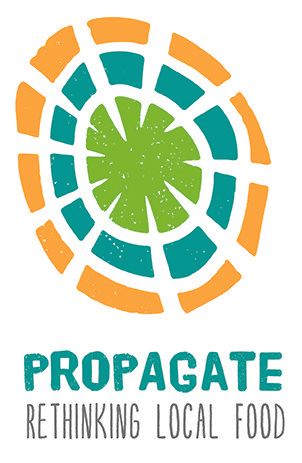How is our Food System Broken?

Our food system is broken. Or is it? It seems to be working perfectly well for those who control it – hint, that’s not most of us…
96% of all food sold to consumers in the UK is purchased through 9 major retailers. 65% of the world’s agricultural land is controlled by 1% of farms. 4 companies account for 70% of global trade in agricultural commodities.i;ii
Who does this food system serve? Mainly shareholders, most of whom are large investment companies. For example, Tesco’s biggest shareholders are investment management companies based in London and the US, for example. The supermarket giant is worth around £21bn,iii reporting a pre-tax profit of just under £2.3bn in the year ending February 2024.iv PepsiCo, one of the world’s largest food manufacturers owning 23 brands, reported an annual gross profit in 2023 of $49.59bn, up 8.24% on 2022.v The vast majority of PepsiCo’s shareholders are institutional investors.
Our food system is complex: it’s more than production, retail and export. Our food system has multiple dimensions – political, social, environmental, economic and health. The profits of global food companies described previously hide the externalities and negative impacts (on the environment and on public health, for example) behind the GDP (gross domestic product) and growth mantra. Our food system is broken.
It’s broken for farmers: low farm gate prices are propped up by subsidies – a system created after the second world war to make sure no one went hungry again. An admirable aim, but it’s resulted in a farming system that prioritises production and high yield over nature and nutrition, and a food system that undervalues the work of farmers and food producers. To illustrate this, Unpicking Food Prices by Sustainvi reported that, for a 480g pack of cheddar purchased in a supermarket the dairy farmer has high production costs of £1.48 yet receives 0.02% in profit (much less than a penny) of the selling price of £2.50.
This system has also created compartmentalised and segregated production. Scotland produces lots of beef, lamb, dairy, salmon and whisky, but is worryingly short on other core products. Arable farming (crop production) accounts for only 10% of Scottish agriculturevii of which most is barley, grown for alcohol production, and wheat and maize grown largely for animal feedviii. Fruit and vegetable production accounts for a tiny proportion.
The food system is broken for consumers: food prices have increased dramatically in recent years, largely due to climate change, Brexit and the impact of international conflicts. For example, the price of a dozen eggs increased by 53 per cent from £2.15 in October 2021 to £3.31 in August 2023, and the cost of a block of cheddar cheese grew by 40 per cent over 2 years, to £8.86 in October 2023.ix Cooking oil production, whether Spanish olive oil or British vegetable oil, is being affected by climate extremes causing huge price increases for consumer. It has been estimated that climate change has added £361 to food bills in the past couple of yearsx.
We have a public health crisis: despite huge efforts Scotland still has high levels of diet-related ill health. The proportion of children at risk of overweight and obesity in Scotland in 2022 was 33%, the highest figure recorded in the Scottish Health Survey since 2011. The figure is higher in areas of deprivation. Achieving Scottish Government’s ambition to halve childhood obesity by 2030 will be difficult.xi
We all know that too many people in Scotland face food inequalities, by which I mean issues around accessibility, affordability and availability of good food and healthier options compared to foods with high levels of fat, salt and sugar. Most people know what they should be eating,xii but the food environments we live in and the food that is available and within our budgets, not to mention the countless other pressures on household incomes, all have a massive impact on what ends up on our plates.
The food system is broken for workers: a report last year from Landworkers Alliance shines a light on the exploitation in the UK immigration system with regard to seasonal fruit and veg pickers.xiii ‘Zero hours’ contracts are still common across the food sector resulting in unstable and unsustainable employment, fluctuating incomes and pressure on people to work even when sick, or cancelling shifts at no notice.
The food system is broken for smaller independent food enterprises: they face the same issues as consumers around availability and price of produce and key ingredients, plus increased energy costs, staffing costs and other overheads. We’ve all seen cafes and small shops come and go over the last few years.
The food system is broken for nature: high yield-focused production has resulted in widespread biodiversity loss and pollution caused by the use of chemical herbicides to kill unwanted plants, pesticides to kill unwanted bugs (both of which also kill useful plants and bugs), and fertilisers to replace natural fertility lost from the soils through ploughing and use of chemicals.xiv;xv
Surplus food is a symptom of a broken food system: feeding people who are food insecure with surplus food is a sticking plaster, not a long-term solution.xvi Surplus food results from supply-side dynamics including incentives for food producers and supermarkets to divert food from waste management systems. As many charities in receipt of surplus food will know, you don’t get much choice with food redistributed from supermarkets and supply chains. Produce is often at its use by date and frequently higher in fat, sugar and salt.
Despite attempts to redistribute food, much of it still goes to waste. It is estimated that food waste in the UK was 10.7 million tonnes in 2021 (a quarter of all food purchased). Around 70% of all wasted food is edible (rather than inedible scraps). The top 5 wasted foods in the UK are bread, potatoes, milk, bananas and fruit and vegetables.
Reflecting on the profits of global food businesses in the context of all of these issues makes you wonder, again – who is this system working for?
i Shining a Spotlight: A critical assessment of food and beverage companies' delivery of sustainability commitments - Oxfam Policy & Practice
ii agrifoodatlas2017_facts-and-figures-about-the-corporations-that-control-what-we-eat.pdf
iii Tesco PLC (LON: TSCO) Statistics & Valuation Metrics - Stock Analysis
iv Tesco Annual Report 2024 (tescoplc.com)
v Pepsico Stock Ownership - Who Owns Pepsico in 2024? | WallStreetZen
vi Unpicking food prices: Where does your food pound go, and why do farmers get so little? | Sustain (sustainweb.org)
vii A New Blueprint For Scotlands Arable Sector (www.gov.scot)
viii A New Blueprint For Scotlands Arable Sector (www.gov.scot)
ix Why food prices are still rising despite UK inflation falling – and what it means for key items (inews.co.uk)
x food-prices-nov-2023-ECIU.pdf (edcdn.com)
xi obesity-prevalence-factsheet-2022-23-data.pdf (obesityactionscotland.org)
xii Healthy and Sustainable Diets: Consumer Poll | Food Standards Agency
xiii NEW LWA REPORT DIGS INTO EXPLOITATION OF MIGRANT WORKERS IN UK HORTICULTURE - Landworkers Alliance
xiv Agrochemicals, Environment, and Human Health | Annual Reviews
xv Evidence review on the influence of agriculture and land use change on lowland biodiversity in Northern Ireland (theoep.org.uk)
xvi Surplus Food and the Rise of Charitable Food Provision | Oxford Research Encyclopedia of Food Studies



